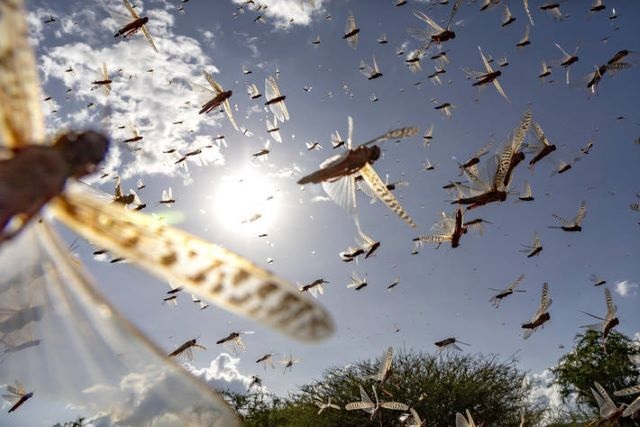
Kampala, Uganda | XINHUA | As African countries continue to battle the unrelenting COVID-19 pandemic, they are making gains on the frontline against massive swarms of the desert locusts that have been threatening the region’s food security.
Experts in different countries attribute the gains against the voracious migratory pests to combined country, regional and international support.
The Food and Agriculture Organization of the United Nations (FAO) in its update report in April warned that the locust upsurge continues to remain alarming, particularly in Ethiopia, Kenya and Somalia, where it poses an unprecedented threat to food security and livelihoods.
Faced with this threat, Eastern African countries ramped up measures, conventional and unconventional, to fight the deadly insects which were exacerbating an already precarious situation due to the COVID-19 pandemic, which has ravaged economies, forcing thousands out of employment and unable to fend for themselves.
Countries with support from development partners including international financiers like the World Bank availed financial and technical resources to fight the locusts.
Cyril Ferrand, the FAO resilience team leader for East Africa, recently said the region has made significant progress towards eradication of the locusts.
Ferrand said in late July that for the case of Kenya, within weeks, the country should be free of large-scale infestations.
He said only two out of the 29 counties in Kenya that were infested by desert locusts in February are yet to contain them.
“We are still assessing the damage, but we have noticed abnormal poor livestock body condition in areas where desert locusts were present,” said Ferrand.
He said that in Turkana County in northern Kenya, sorghum crops with around 15 to 20 percent damage to the yield linked to the pests had been reported.
The expert said from the beginning of January to the end of June, FAO and regional governments had cushioned nearly 600,000 hectares from desert locusts.
“We estimate that so far we have killed over 400 billion locusts in the entire region. That is really a lot. That is 400 to 500 billion locusts that were prevented from damaging crops and range lands,” said Ferrand.
Ugandan President Yoweri Museveni said that the country has succeeded in the fight against the locusts that migrated from neighboring western Kenya to the eastern and northern parts of the country.
The country’s military working with the locals are fighting the swarms using hand spray pumps instead of waiting for spray aircraft, Museveni said.
The government has studied the movement of the locusts, he said, noting that the military would spray them even at night when the migratory insects cannot fly.
Uganda has already deployed over 2,000 soldiers and 835 civilian personnel, including agriculture extension officers.
China is among the countries that have donated chemicals and equipment to help Uganda fight the locusts that were threatening the country’s food security.
“It (donation) will take us very far in this effort of ensuring food security for the people of Uganda,” Vincent Ssempijja, Uganda’s minister of agriculture said on June 10 while receiving the Chinese donation.
Zheng Zhuqiang, Chinese ambassador to Uganda, said the 20 tonnes of chemicals and equipment is aimed at boosting Uganda’s efforts in minimizing the impact of the desert locusts.
FAO Uganda earlier warned that the locust invasion could severely threaten food and nutrition security for about 1.3 million people in the northeastern and eastern parts of the country.
According to the ministry of agriculture, the country’s ongoing efforts have started paying off. The ministry said the efforts have averted a potential loss worth about 800 million U.S. dollars arising from protection of food and cash crops in the affected areas.
Ferrand warned that Ethiopia is still infested with a second breeding generation, and also partly re-infested by swarms from Kenya.
He said that FAO is fighting the second generation of desert locusts that have been successful but the threat of possible re-infestation towards the end of the year calls for enhanced surveillance.
The number of food insecure people in East Africa is estimated to increase this year to more than 41 million as a result of COVID-19, including 14 million who are estimated to live in urban areas, according to a joint announcement earlier this month by the United Nations Human Settlements Programme (UN-Habitat) and the World Food Programme (WFP), as they jointly called for the promotion and development of socially and environmentally sustainable cities and towns across the East Africa region in the face of the ongoing COVID-19 pandemic.
“Urban populations in East Africa are highly vulnerable to the COVID-19 pandemic. Particularly 35 million people, or 58 percent of the urban populations living in informal settlements who are at high risk from its impact,” the UN Habitat and WFP warned in their joint situation update.
The FAO and its partners also stressed that COVID-19-inflicted movement restrictions and border lockdowns are also disrupting food logistics and supply chains, which in turn has reduced food availability and increased post-harvest losses in parts of the region.
“Restrictions are impacting the movement and supply of agricultural inputs, including labor, fertilizers, pesticides and equipment, thus posing serious challenges to foodproduction,” the joint statement read.
As of July 22, 2020, the additional humanitarian requirements, on top of government resources, for food security, nutrition and livelihood support are 3.4 billion U.S. dollars for seven IGAD member states that are Djibouti, Ethiopia, Kenya, Somalia, South Sudan, Sudan, and Uganda.
“These requirements are just 33 percent funded, leaving a funding gap of 2.3 billion U.S. dollars, as per country-level humanitarian response plan, flash appeals, inter-sectoral COVID-19 response plans, and the global COVID-19 humanitarian response plan,” according to the joint statement.
“This requires urgent attention considering that many governments will likely face significant difficulties responding to this large-scale crisis on their own,” it added.
******
XINHUA
 The Independent Uganda: You get the Truth we Pay the Price
The Independent Uganda: You get the Truth we Pay the Price



